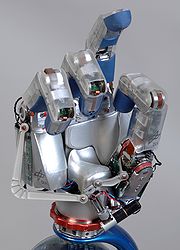Could a robot serve your morning cuppa?
Engineers and scientists of DLR (German aerospace centre) in Oberpfaffenhofen are engaged in the robotics of tomorrow, in particular 'the gentle hand'. The human hand is a wonder of nature: what seems apparent to us becomes, on closer inspection or under a technical simulation, a highly complex entity. The complex boards are produced on the Essemtec SMT assembler Paraquda in a highly flexible environment.
The experience of the German aerospace centre in regard of the development, installation and use of robotic-hands reaches back to 1993 and covers all sectors of the mechatronic hand development and control including telemanipulation, autonomic gripping and manipulation. At its presentation in 2001 the DLR Hand II was the most progressive robot-hand worldwide. Based on the original two DLR-Hit-Hand variations, I & II, have been developed. In 2008 the aerospace centre introduced the DLR hand arm system.
The company claims that this is still the most complex robot-hand to date, with 36 motors and 20 degrees of freedom. In respect of size and capability it’s comparable with a human hand, and that’s what makes it special. This system shows the long experience DLR has with cable conducted passively flexible robot-hands. The latest development is the space hand DEXHAND. This hand combines the modular finger concept of DLR Hand II with cable conducted fingers and is the size of an astronaut’s glove.
 DLR Hand II is a multifunctional anthropomorphic gripping and manipulation device. It consists of four identic fingers each with four joints and three degrees of freedom. An additional degree of freedom in the palm allows the hand to respond to any task – whether it be firm gripping or gentle manipulation of objects. The complete package of drive, sensors and communication integration leads to a high level of flexibility and allows a simple connection with different robot-arms. A multitude of different sensors enables precise control of the hand with simultaneous sensitive return of the finger’s forces and positions. This is very important for the hand’s intuitive comprehension during tele manipulation.
DLR Hand II is a multifunctional anthropomorphic gripping and manipulation device. It consists of four identic fingers each with four joints and three degrees of freedom. An additional degree of freedom in the palm allows the hand to respond to any task – whether it be firm gripping or gentle manipulation of objects. The complete package of drive, sensors and communication integration leads to a high level of flexibility and allows a simple connection with different robot-arms. A multitude of different sensors enables precise control of the hand with simultaneous sensitive return of the finger’s forces and positions. This is very important for the hand’s intuitive comprehension during tele manipulation.
The main field of application of the DLR Hand II is the bimanual manipulation on the two humanoid robots Rollin Justin and Agile Justin. Concepts for the hand/arm co-ordination are tested on them. A further field of research is dynamic grip planning and manipulation. For example, for a future application in housekeeping robot-hands should preferably be simple and robust which is why different utilisations are tested on this hand.
Mechanical design:
- Four identical fingers with four joints and three degrees of freedom in each
- Open aluminium frame structure with printed plastic case
- 13 degrees of freedom 30
- N active finger force
- Joint velocity approximately 360°/s
- Weight 1.8kg
Electronic design:
- Electronic sensor located directly by the sensors
- A/D conversion in each finger. Serial communication system between the fingers and the hand’s base to get by with as few cables as possible
- Hot pluggable automatic tooling system







